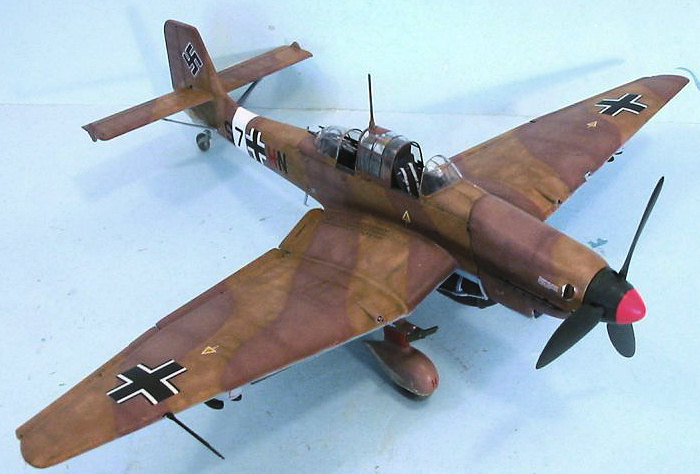
| KIT: | Hasegawa 1/32 Ju-87D Stuka |
| KIT #: | ST 26 |
| PRICE: | ¥5,600 at www.hlj.com |
| DECALS: | Two options |
| REVIEWER: | Tom Cleaver |
| NOTES: | Eduard 'Big Ed' set, Rutman blades and canopy used |

| HISTORY |
The Junkers Ju-87 Stuka is rightfully one of the most famous aircraft of the Second World War. The name “Stuka” is a contraction of Sturzkampfflugzeug, which translates literally as “plunging combat aircraft.”
Following the success of the Ju-87B series in the Polish campaign and the
blitzkrieg of May and June 1940, Junkers began a redesign of the aircraft to
take advantage of the new Jumo 211J-1 engine, which introduced an induction air
cooler, strengthened crankshaft, fully-shrouded DVL supercharger impeller, a
modified boost an injection pump control, and a pressurized coolant system. The
new engine provided 1,400 h.p., a useful increase. The design of the Ju-87D
made a serious attempt to clean up the airframe aerodynamically, with improved
cowling lines that put the oil cooler below the engine where the radiator had
originally been, and relocating the radiator system beneath the wing center
section. The landing gear pants were reduced in size while the vertical fin and
rudder were enlarged to provide directional stability with the new powerplant.
Crew armor was increased and the rear armament was changed from a single MG17 to
a twin MG81 zwilling mount. Maximum bomb load over short ranges was
increased to 3, 968 pounds, though the aircraft normally only carried a single
2,205-lb SC1000 bomb. The underwing racks could
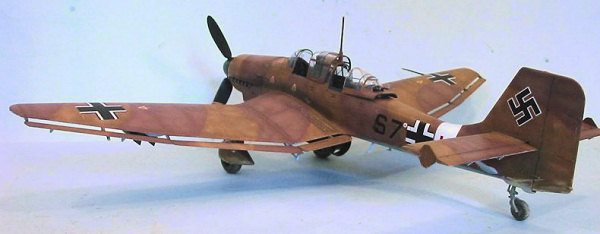 each carry a single 551-lbsSC250
or a 1,000 lb SC500 bomb, or two 110-lb SC50 bombs.
each carry a single 551-lbsSC250
or a 1,000 lb SC500 bomb, or two 110-lb SC50 bombs.
The Ju-87D-1 supplanted the Ju-87B-2 on the production line in the spring of 1941, though it was officially considered an “interim” type pending the availability of aircraft with higher performance, and production was reduced from 70 aircraft a month in January 1941 to 12 per month that September. In November, realizing that the newer aircraft were delayed and might not appear in quantity anytime soon, the Stuka’s priority was changed. Having delivered on 476 aircraft in 1941, deliveries jumped to 817 for 1942.
The Ju-87D-1 appeared on both the Eastern Front and in the Mediterranean in January 1942 and the Stukagruppen converted from the earlier Ju-87B through the spring and summer. Operation of dive bombers was becoming more and more difficult through 1942 as opposing fighters increased their numbers, and the Ju-87D-1 was replaced by the Ju-87D-3 which was intended more as a schlactflugzeug than a traditional dive bomber, though it retained dive brakes. The Hungarian, Romanian and Italian air forces began operating Ju-87Ds in late 1942.
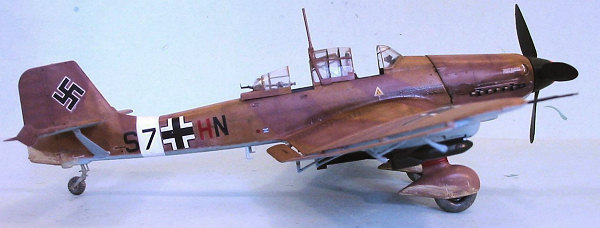 The Ju-87D-5 which appeared
in 1943 had an increased wingspan and wing armament upgraded from 7.62mm machine
guns to MG151 20mm cannon. Production increased rapidly, with 1,844 produced in
1943 with peak monthly production coming that March when 192 Stukas were
delivered.
The Ju-87D-5 which appeared
in 1943 had an increased wingspan and wing armament upgraded from 7.62mm machine
guns to MG151 20mm cannon. Production increased rapidly, with 1,844 produced in
1943 with peak monthly production coming that March when 192 Stukas were
delivered.
The Ju-87D took part in the Malta campaign and the North African campaign, operated by Stuka Geschwader 3 in the Mediterranean, while Stuka Geschwader 1 operated on the Eastern front. In June 1942, Ju-87D-1s operated by St.G.3 attacked the fortress of Bir Hacheim and the fortress of Tobruk, resulting in the surrender of both. Increasing Allied air strength and reductions in available avgas resulted in the withdrawal of the Stukas from North Africa so that by the time of the surrender in Tunisia in May 1943, all Stukas had been withdrawn to Sicily and Italy.
Ju-87Ds operated in the night attack role in Italy and the Western and Eastern Fronts until the end of the war.
| THE KIT |
This kit is a development of the earlier Ju-87G-2 Stuka released a year ago. This kit differs from the previous kit in providing the dive brakes, outer bomb racks and the SC1000 and SC50 bombs. The kit can be made as a Ju-87D-1 with the short-span wing or the Ju-87D-5 with the long-span wing. Decals are provided for a Ju-87D-1 flown by Oberstleutnant Walter Siegel, Kommodore of St.G.3 in October 1942 at the Battle of El Alamein, or a Ju-87D-5 of III/SG 2 flown by Hans-Ulrich Rudel on the Eastern Front in the spring of 1944.
| CONSTRUCTION |
I
utilized the Eduard “Big Ed” set for the cockpit interior on this model,
replacing all the instrument panels with the pre-painted photoetch sets. I also
used the new Eduard Luftwaffe seat belts, which are multi-part assemblies that
look very realistic when completed. I have to say that I like these pre-painted
sets, since they are able to produce better and more realisti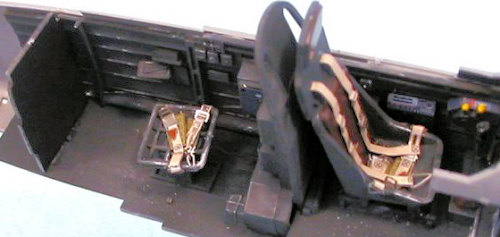 c
detail than my old eyes can do nowadays with a paintbrush, even when using my
magnifier.
c
detail than my old eyes can do nowadays with a paintbrush, even when using my
magnifier.
I also used the Jerry Rutman resin propeller blades, which are more accurate in shape than what is supplied in the kit. Having discovered that the kit canopy is molded in such a way that it is extremely difficult to open the pilot’s canopy without risk of breaking it while trying to force it into position, I also used Jerry Rutman’s vacuform canopy for the pilot’s canopy, and this was easy to position in the open. I was particularly glad to be able to get this vacuform canopy due to the fact that my first attempt to use the kit canopy resulted in it cracking and breaking right down the middle, making it unusable in any position.
Other than that, the rest of the kit was assembled per instructions without difficulty. I used Mr. Surfacer to get rid of the seams on the fuselage centerline and the wing leading edges.
I did not attach the landing gear until after the model was painted.
| COLORS & MARKINGS |
Painting:
The
big problem with the Stuka is that it was always painted 70-71/65, which is
pretty boring. Fortunately, Stukas used in Nor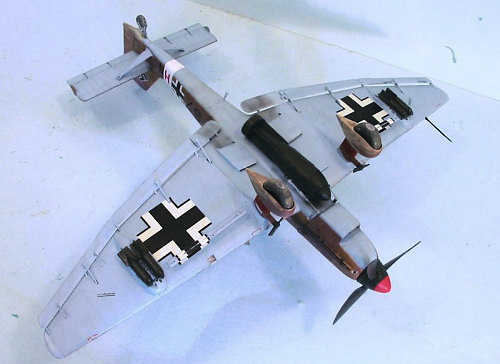 th
Africa received desert camouflage, which varied from overpainting of the
original 70-71 greens with blotches of RLM79 Tan, to some complete repaints such
as overall RLM79 Tan or RLM79 Tan and RLM71 Green and some using Italian
paints. I found a photograph of a Ju-87D-1 of St.G.3 with a two color
camouflage where the darker color seemed too light to be one of the dark
greens. I also found a color profile on the internet that showed a Ju-87D-1
that used an Italian medium dark brown with RLM79 Tan, and decided to do this
airplane just because of the difference in color. I used Xtracrylix RLM 79 Tan
and RAL8002 “Signal Braun”,with both colors being faded using white and light
yellow mixed in to simulate the results of the North African sun. The lower
surface was painted with RLM65 Hellblau. The spinner and prop blades were
painted TLM70 Schwarzgrun, with the forward half of the spinner painted RLM04
Red.
th
Africa received desert camouflage, which varied from overpainting of the
original 70-71 greens with blotches of RLM79 Tan, to some complete repaints such
as overall RLM79 Tan or RLM79 Tan and RLM71 Green and some using Italian
paints. I found a photograph of a Ju-87D-1 of St.G.3 with a two color
camouflage where the darker color seemed too light to be one of the dark
greens. I also found a color profile on the internet that showed a Ju-87D-1
that used an Italian medium dark brown with RLM79 Tan, and decided to do this
airplane just because of the difference in color. I used Xtracrylix RLM 79 Tan
and RAL8002 “Signal Braun”,with both colors being faded using white and light
yellow mixed in to simulate the results of the North African sun. The lower
surface was painted with RLM65 Hellblau. The spinner and prop blades were
painted TLM70 Schwarzgrun, with the forward half of the spinner painted RLM04
Red.
Decals:
I used the kit decals for the national insignia and stenciling, and pieced together decals from the decal dungeon to do the ID letters for an airplane of the 1st Staffel of St.G.3.
| FINAL CONSTRUCTION |
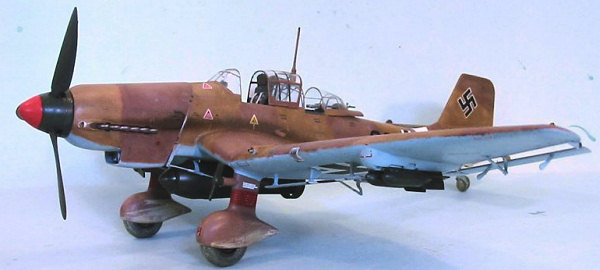 I gave the model two coats
of Xtracrylix Flat Varnish, then applied exhaust staining with Tamiya “Smoke.”
When that was dry I unmasked the canopies and posed the pilot’s and gunner’s
canopies in the open position to better show off the increased cockpit detail
from the Eduard set. I then attached the underwing bombs and the SC1000 bomb
with its crutch.
I gave the model two coats
of Xtracrylix Flat Varnish, then applied exhaust staining with Tamiya “Smoke.”
When that was dry I unmasked the canopies and posed the pilot’s and gunner’s
canopies in the open position to better show off the increased cockpit detail
from the Eduard set. I then attached the underwing bombs and the SC1000 bomb
with its crutch.
| CONCLUSIONS |
This is one model that really wants raised rivets, since the Stuka was not flush-riveted. The lack of this is my only complaint about the kit, and that is minor. The kit is easy to assemble and presents no difficulties, and the Eduard photoetch really increases the detail and adds to the final look. The model looks really good sitting next to the Ju-87G-2 Kannonenvogel.
Thanks to HobbyLink Japan for the review kit. Get yours at “Japanese prices” at www.hlj.com
February 2007
If you would like your product reviewed fairly and quickly by a site that has over 350,000 visitors a month, please contact me or see other details in the Note to Contributors.